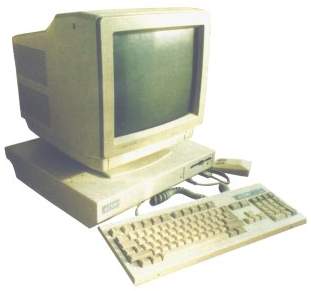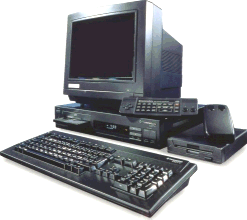Emulation
Amiga Continued:



Amiga 2500 Launch date: 1989
The A2500 systems were based upon the final revisions of the A2000-B motherboard design before the A3000 was released. The first model was released during 1989 and was most popular in the US and Canada, appealing to the high-end user and professional market. There was very little difference from previous revisions of the A2000, the most notable being the addition of processor cards increasing the system speed.
The A2500 range consisted of three specifications:
:-The A2500/020 shipped with an A2620 processor card featuring a 68020 and
68881 14 MHz.
:-The A2500/030 with an A2630 featuring a 68030 and 68882 25 MHz.
:-Of particular interest was the A2500UX. This shipped with AT&T Unix
System V Release 4 operating system rather than a version of the AmigaOS,
as well as a three button mouse. A tape streamer and Ethernet card were an
optional upgrade.
Amiga 1500 Launch date: 1990 Price on launch: £999 Sterling
The A1500 was a UK-specific machine derived from the A2000. Both machines
use a socketed Motorola 68000 7.14 MHz CPU and were shipped with an empty
processor slot. The operating system also remained the same, shipping with
Kickstart 1.3. The only difference is that the Amiga 1500 shipped with two
floppy drives, 1MB Chip RAM and a new nameplate.
The exact reason why Commodore chose to release such a limited machine has remained a mystery for years. Many suggest CBM UK released it to "kill" an A500 desktop conversion unit sold by Checkmate Digital that was also called the A1500. Commodore always had a questionable business sense. By releasing a competitor to another company they were almost certainly attempting to drive potential Amiga suppliers out-of-business, as well as spending large amounts of money on a system that added little to the Amiga market. Alternatively, Commodore may have had a lot of internal floppy drives they wanted to use.
After Commodore released the A1500, First Computers in Leeds released an
unofficial upgraded version called the 1500+, an ECS version of the A1500
that included the 2.04 Kickstart ROM. There was also a later version dubbed
the 1500Deluxe that added an 1.3/2.04 ROM switcher and RAM expansion. Silica
released a similar system called the 2000Plus that dropped the RAM expansion,
only including the ROM switcher.
Amiga CDTV Launched:
June
1990 Launch
Price: 699 UK
Pounds
In 1990 Commodore launched a machine as ground-breaking as the original Amiga, the CDTV. It was basically an A500 in a black video-style case without the keyboard or disk drive and a CD-ROM drive "stuck on". But this was not made it special- it was the approach that Commodore took to selling the machine that set it apart from the Amiga. Rather than a computer it was sold as a consumer device in order to compete with the Philip's CDi. It was criticised by the Amiga fraternity for the lack of expandibility or support from third parties. Until recently it was impossible to upgrade the machine beyond version 1.3 of the OS. It is possible to turn the console into a fully fledged computer by adding a keyboard and disk drive.
The only competition was the Phillips CD-i; Even Commodore could have influenced the development of the CD market to favour their machine, right? However, the CD market was still an unknown that had different requirements to the standard Amiga.
To investigate this further, Commodore hired a study group to research the
area and make recommendations. This resulted in the decision to distance the
CDTV from the computer, promoting it as the next generation VCR. Commodore
insisted that retailers did not physically place it near to other computers.
This led to mass confusion, computer people did not buy it because "it
wasn't a computer", while non-computer people said it was "too much
like a computer." It only sold in small numbers but did introduce the
Amiga to the advantages of CD as a storage method.
Amiga CDTV-CR Year of completion: 1992
Over the years there have been a number of rumours that Commodore developed a follow-up to the CDTV. Many believed it was a CDTV with a DCTV built-in, others said it was an expanded machine with AmigaOS2, more memory, keyboard and disk drive. These rumours were confirmed in March 2000 when two machines appeared on eBay. The first was sold for $199, the second for $1000. A third prototype was owned by National Amiga, who sold it to Oliver Hannaford-Day, the CDTV.org administrator for $250.
Unlike other Amiga CR revisions, the CDTV CR was completely redesigned, utilizing the updated Amiga 600 technology. According to existing information, the feature list for the machine
CPU 68000 7.14 Mhz CPU
Chipset Enhanced Chipset (ECS), 2 Meg Angus
Memory 1MB Chip RAM,
72-pin SIMM connector
Operating System: Kickstart 2.05 (one of the prototypes have been upgraded
to OS 3.1), FMV software may have been built-in
Expansion: 44 pin 2.5" IDE connector
PCMCIA card (replaces the proprietary memory card)
Expansion slot on modulator for FMV card (early version of CD32 FMV card)
Macintosh-style serial port
Amiga video connector has now been moved onto the modulator card.
Drives: 880Kb 3.5" floppy disk drive
CD-ROM